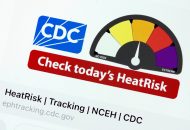Annual Report to the Nation Finds Changes in Cancer Trends

The Annual Report to the Nation on the Status of Cancer shows that while there has been a rapid decrease in lung cancer and melanoma deaths, previous declining trends for cancers like prostate or breast cancer have slowed or disappeared.
“It’s clear that obesity causes or is strongly associated, perhaps in a causative manner, with many types of cancer, and those are the cancers in the United States that we’re seeing increase in incidence and increase in mortality, predominantly the ones associated with obesity,” Norman Sharpless, director of the National Cancer Institute.
The report which examines the period of 2001 to 2018 is a collaborative effort of the American Cancer Society, the Centers for Disease Control and Prevention, the National Cancer Institute, and the North American Association of Central Cancer Registries.
On average cancer death rates decreased 2.2% per year among males, and 1.7% per year among females, according to the report.
However, last year the report indicated that the overall decline of colorectal cancer was leveling off, and similarly the trend for female breast cancer was in a steep decline, but the trends in the latest report show an increase.
“The decline in colorectal cancer is less steep and the decrease for female breast cancer has reversed,” said co-author of the report Recinda Sherman, program manager of Data Use and Research at the NAACCR.
There was also an increase in death rates for brain and other nervous system cancers, pancreas in both sexes, oral cavity, pharynx in males, liver and uterus in females.
Risk factors such as the obesity epidemic, alcohol consumption, and lower physical activity levels are likely driving factors for the changes in trends seen in incidence and death rates for cancers like prostate or female breast seen in previous annual reports according to researchers.
“There is a national epidemic of obesity, and this will continue to play out in terms of worsening cancer statistics if we don’t collectively do something about that as a country,” said Sharpless.
According to Sharpless, research suggests that physical activity can help with survival in patients with certain cancers, but he said that effective approaches to help patients with obesity need to start with understanding why it happens in the first place.
“Regular physical activity not only helps prevent obesity, a risk factor for many cancers, it also helps to reduce inflammation, to strengthen your immune system, and it may protect against cancers of the breast, colon, kidneys, and more. Aim for about 30 minutes of physical activity daily by taking walks, playing sports with your family and friends, or other ways of moving that are enjoyable to you,” said Sharpless.
Researchers found that obesity was not the only risk factor which is spurring changes in certain cancer incidence rates and death rates.
“Particularly for breast cancer and colorectal cancer, the obesity epidemic, lower physical activity levels, and increase in alcohol consumption, particularly the increase among women, are likely driving factors. And the pattern of fewer children and older age at first birth, are also likely contributors to the increase of female breast cancer burden,” said Sherman.
Although the report provides cancer statistics prior to the COVID-19 pandemic, researchers are concerned that regular cancer screenings, other cancer prevention, and control medical care may have been postponed during 2020, based on emerging studies of electronic health records and claims reporting a drop in cancer screening rates, and health care visits following the pandemic.
“We expect this will lead to a short-term decline in incidence rates, not due to a change in risk but a reflection on postponing medical care and, ultimately, diagnoses. We are concerned this will lead to long-term increase in late-stage disease, which may lead to increases in cancer-related mortality,” said Sherman.
Sherman said that more individual-level clinical support is needed for low resource persons to better understand how health disparities are largely driven by social factors that impact the health of communities as a whole.
“It is important for health care providers to be aware of the cancer risks in the populations they serve, this must be coupled with health policy aimed at removing systems-level barriers to health and wellness,” said Sherman.























